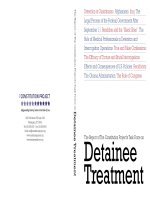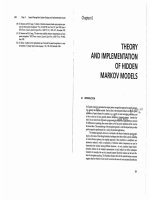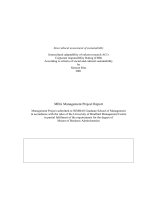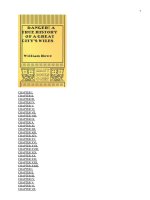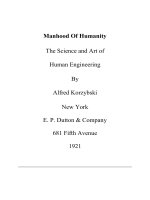Fundamentals of earthquake engineering amr s elnashai luigi di sarno
Bạn đang xem bản rút gọn của tài liệu. Xem và tải ngay bản đầy đủ của tài liệu tại đây (15.09 MB, 366 trang )
FUNDAMENTALS OF
EARTHQUAKE
ENGINEERING
Amr S. Elnashai
Department of Civil and Environmental Engineering, University of Illinois, USA
and
Luigi Di Sarno
Department of Structural Analysis and Design, University of Sannio, Benvenuto, Italy
A John Wiley & Sons, Ltd, Publication
FUNDAMENTALS OF
EARTHQUAKE
ENGINEERING
FUNDAMENTALS OF
EARTHQUAKE
ENGINEERING
Amr S. Elnashai
Department of Civil and Environmental Engineering, University of Illinois, USA
and
Luigi Di Sarno
Department of Structural Analysis and Design, University of Sannio, Benvenuto, Italy
A John Wiley & Sons, Ltd, Publication
This edition first published 2008
© 2008 John Wiley & Sons, Ltd
Registered office
John Wiley & Sons Ltd, The Atrium, Southern Gate, Chichester, West Sussex, PO19 8SQ, United Kingdom
For details of our global editorial offices, for customer services and for information about how to apply for
permission to reuse the copyright material in this book please see our website at www.wiley.com.
The right of the author to be identified as the author of this work has been asserted in accordance with the
Copyright, Designs and Patents Act 1988.
All rights reserved. No part of this publication may be reproduced, stored in a retrieval system, or transmitted, in
any form or by any means, electronic, mechanical, photocopying, recording or otherwise, except as permitted by
the UK Copyright, Designs and Patents Act 1988, without the prior permission of the publisher.
Wiley also publishes its books in a variety of electronic formats. Some content that appears in print may not be
available in electronic books.
Designations used by companies to distinguish their products are often claimed as trademarks. All brand names
and product names used in this book are trade names, service marks, trademarks or registered trademarks of their
respective owners. The publisher is not associated with any product or vendor mentioned in this book. This
publication is designed to provide accurate and authoritative information in regard to the subject matter covered.
It is sold on the understanding that the publisher is not engaged in rendering professional services. If professional
advice or other expert assistance is required, the services of a competent professional should be sought.
Library of Congress Cataloging-in-Publication Data
Elnashai, Amr S.
Fundamentals of earthquake engineering / Amr S. Elnashai and Luigi Di Sarno.
p. cm.
Includes bibliographical references and index.
ISBN 978-0-470-02483-6 (Hbk) 1. Earthquake engineering. I. Di Sarno, Luigi.
TA654.6.E485 2008
624.1’762–dc22
II. Title.
2008033265
ISBN: 978-0-470-02483-6 (Hbk)
A catalogue record for this book is available from the British Library.
Set in 9 on 11pt Times by SNP Best-set Typesetter Ltd., Hong Kong
Printed in England by Antony Rowe Ltd, Chippenham, Wilts.
Contents
About the Authors
ix
Foreword
xi
Preface and Acknowledgements
xiii
Introduction
xv
List of Abbreviations
xix
List of Symbols
xxi
1 Earthquake Characteristics
1.1 Causes of Earthquakes
1.1.1 Plate Tectonics Theory
1.1.2 Faulting
1.1.3 Seismic Waves
1.2 Measuring Earthquakes
1.2.1 Intensity
1.2.2 Magnitude
1.2.3 Intensity–Magnitude Relationships
1.3 Source-to-Site Effects
1.3.1 Directional Effects
1.3.2 Site Effects
1.3.3 Dispersion and Incoherence
1.4 Effects of Earthquakes
1.4.1 Damage to Buildings and Lifelines
1.4.2 Effects on the Ground
1.4.3 Human and Financial Losses
References
1
1
1
6
9
14
15
18
24
25
26
27
30
32
34
36
40
44
2 Response of Structures
2.1 General
2.2 Conceptual Framework
2.2.1 Definitions
2.2.2 Strength-versus Ductility-Based Response
47
47
47
47
48
vi
Contents
2.2.3 Member-versus System-Level Consideration
2.2.4 Nature of Seismic Effects
2.2.5 Fundamental Response Quantities
2.2.6 Social-Economic Limit States
2.3 Structural Response Characteristics
2.3.1 Stiffness
2.3.2 Strength
2.3.3 Ductility
2.3.4 Overstrength
2.3.5 Damping
2.3.6 Relationship between Strength, Overstrength and Ductility:
Force Reduction Factor ‘Supply’
References
49
51
53
54
56
56
73
85
101
106
3
3.1
3.2
3.3
Earthquake Input Motion
General
Earthquake Occurrence and Return Period
Ground-Motion Models (Attenuation Relationships)
3.3.1 Features of Strong-Motion Data for Attenuation Relationships
3.3.2 Attenuation Relationship for Europe
3.3.3 Attenuation Relationship for Japan
3.3.4 Attenuation Relationships for North America
3.3.5 Worldwide Attenuation Relationships
Earthquake Spectra
3.4.1 Factors Influencing Response Spectra
3.4.2 Elastic and Inelastic Spectra
3.4.3 Simplified Spectra
3.4.4 Force Reduction Factors (Demand)
3.4.5 Design Spectra
3.4.6 Vertical Component of Ground Motion
3.4.7 Vertical Motion Spectra
Earthquake Records
3.5.1 Natural Records
3.5.2 Artificial Records
3.5.3 Records Based on Mathematical Formulations
3.5.4 Scaling of Earthquake Records
Duration and Number of Cycles of Earthquake Ground Motions
Use of Earthquake Databases
Software for Deriving Spectra and Generation of Ground-Motion Records
3.8.1 Derivation of Earthquake Spectra
3.8.2 Generation of Ground-Motion Records
References
119
119
119
122
124
125
126
127
128
129
129
130
137
144
150
152
153
155
155
159
160
161
168
173
174
175
178
179
Response Evaluation
General
Conceptual Framework
Ground Motion and Load Modelling
Seismic Load Combinations
185
185
185
186
189
3.4
3.5
3.6
3.7
3.8
4
4.1
4.2
4.3
4.4
111
115
Contents
vii
4.5 Structural Modelling
4.5.1 Materials
4.5.2 Sections
4.5.3 Components and Systems for Structural Modelling
4.5.4 Masses
4.6 Methods of Analysis
4.6.1 Dynamic Analysis
4.6.2 Static Analysis
4.6.3 Simplified Code Method
4.7 Performance Levels and Objectives
4.8 Output for Assessment
4.8.1 Actions
4.8.2 Deformations
4.9 Concluding Remarks
References
191
194
200
203
217
220
222
232
239
244
249
250
251
257
258
Appendix A – Structural Configurations and Systems for Effective
Earthquake Resistance
263
Appendix B – Damage to Structures
291
Index
337
About the Authors
Professor Amr Elnashai
Professor Amr Elnashai is Bill and Elaine Hall Endowed Professor at the Civil and Environmental
Engineering Department, University of Illinois at Urbana-Champaign. He is Director of the National
Science Foundation (NSF) multi-institution multi-disciplinary Mid-America Earthquake Center. He is
also Director of the NSF Network for Earthquake Engineering Simulation (NEES) Facility at Illinois.
Amr obtained his MSc and PhD from Imperial College, University of London, UK. Before joining the
University of Illinois in June 2001, Amr was Professor and Head of Section at Imperial College. He
has been Visiting Professor at the University of Surrey since 1997. Other visiting appointments include
the University of Tokyo, the University of Southern California and the European School for Advanced
Studies in Reduction of Seismic Risk, Italy, where he serves on the Board of Directors since its founding in 2000. Amr is a Fellow of the Royal Academy of Engineering in the United Kingdom (UKequivalent of the NAE), Fellow of the American Society of Civil Engineers and the UK Institution of
Structural Engineers.
He is founder and co-editor of the Journal of Earthquake Engineering, editorial board member of
several other journals, a member of the drafting panel of the European design code, and past senior
Vice-President of the European Association of Earthquake Engineering. He is the winner of the Imperial
College Unwin Prize for the best PhD thesis in Civil and Mechanical Engineering (1984), the Oscar
Faber Medal for best paper in the Institution of Structural Engineering, and two best paper medals from
the International Association of Tall Buildings, Los Angeles. He is the administrative and technical
team builder and director of both the MAE Center and NEES@UIUC Simulation Laboratory, at
Illinois.
Amr is President of the Asia-Pacific Network of Centers of Earthquake Engineering Research
(ANCER), a member of the FIB Seismic Design Commission Working Groups and two Applied Technology Council (ATC, USA) technical committees. He founded the Japan–UK Seismic Risk Forum in
1995 and served as its director until 2004. He leads a FEMA project for impact assessment for the eight
central US states, was advisor to the UK Department of the Environment, advisor to the Civil Defense
Agency of Italy, and review panel member for the Italian Ministry of Research and the New Zealand
and Canadian Science Research Councils.
Amr’s technical interests are multi-resolution distributed analytical simulations, network analysis,
large-scale hybrid testing, and field investigations of the response of complex networks and structures
to extreme loads, on which he has more than 250 research publications, including over 110 refereed
journal papers, many conference, keynote and prestige lectures (including the Nathan Newmark Distinguished Lecture), research reports, books and book chapters, magazine articles, and field investigation reports. Amr has successfully supervised 29 PhD and over 100 Masters Theses. Many of his
students hold significant positions in industry, academia and government in over 12 countries. He has
a well-funded research group, with a large portfolio of projects from private industry, state agencies,
x
About the Authors
federal agencies, and international government and private entities. Amr taught many different subjects
both at Illinois and at Imperial College. He is recognized as an effective teacher and has been on the
‘incomplete list of teachers considered excellent by their students’ twice at UIUC.
He has contributed to major projects for a number of international companies and other agencies
such as the World Bank, GlaxoWellcome (currently GSK), Shell International, AstraZeneca, Minorco,
British Nuclear Fuels, UK Nuclear Installations Inspectorate, Mott MacDonald, BAA, Alstom Power,
the Greek, Indonesian and Turkish Governments, and the National Geographic Society. He is currently
working on large projects for the Federal Emergency Management Agency (FEMA), State Emergency
Management Agencies, Istanbul Municipality, US AID, Governments of Pakistan and Indonesia, among
others. Amr enjoys scuba-diving and holds several certificates from the British Sub-Aqua Club and the
US Professional Association of Diving Instructors. He also enjoys reading on history, the history of
painting and film-making.
Dr Luigi Di Sarno
Dr. Luigi Di Sarno is Assistant Professor in Earthquake Engineering at the University of Sannio
(Benevento), and holds the position of Research Associate at the Department of Structural Engineering
(DIST), University of Naples, Federico II in Italy. He graduated cum laude in Structural Engineering
from the University of Naples, Federico II. He then obtained two MSc degrees in Earthquake Engineering and Structural Steel Design from Imperial College, London. In 2001 Dr. Di Sarno obtained his PhD
from University of Salerno in Italy and moved to the University of Illinois at Urbana Champaign in
2002 where he worked as a Post-doctoral Research Associate. He has been Visiting Professor at the
Mid-America Earthquake Center at Illinois since 2004. His research interests are seismic analysis and
design of steel, reinforced concrete and composite structures, and the response of tall buildings to
extreme loads, on which he has written more than 60 research publications, including over 15 refereed
journal papers, many conference papers, research reports, book chapters and field investigation reports.
Dr. Di Sarno continues to work with the active research group at the University of Naples, with a large
portfolio of projects from private industry, state agencies, and international government and private
entities. He taught several courses at Naples, Benevento and the Mid-America Earthquake Center. He
is currently working on large projects funded by the Italian State Emergency Management Agency
(DPC) and the Italian Ministry of Education and Research, amongst others. Dr. Di Sarno enjoys reading
on history, science and art. He also enjoys playing tennis and swimming.
Foreword
Congratulations to both authors! A new approach for instruction in Earthquake Engineering has been
developed. This package provides a new and powerful technique for teaching – it incorporates a book,
worked problems and comprehensive instructional slides available on the web site. It has undergone
numerous prior trials at the graduate level as the text was being refined.
The book, in impeccable English, along with the virtual material, is something to behold. ‘Intense’
is my short description of this book and accompanying material, crafted for careful study by the student,
so much so that the instructor is going to have to be reasonably up-to-date in the field in order to use
it comfortably. The writer would have loved to have had a book like this when he was teaching Earthquake Engineering.
The text has four main chapters and two appendices. The four main chapters centre on (a) Earthquake
Characteristics, (b) Response of Structures, (c) Earthquake Input Motions and (d) Response Evaluation,
with two valuable appendices dealing with Structural Configurations and Systems for Effective Earthquake Resistance, and Damage to Structures. The presentation, based on stiffness, strength and ductility
concepts, comprises a new and powerful way of visualizing many aspects of the inelastic behaviour
that occurs in structures subjected to earthquake excitation.
The book is written so as to be appropriate for international use and sale. The text is supplemented
by numerous references, enabling the instructor to pick and choose sections of interest, and to point
thereafter to sources of additional information. It is not burdened by massive reference to current codes
and standards in the world. Unlike most other texts in the field, after studying this book, the students
should be in a position to enter practice and adapt their newly acquired education to the use of regional
seismic codes and guidelines with ease, as well as topics not covered in codes. Equally importantly,
students who study this book will understand the bases for the design provisions.
Finally, this work has application not only in instruction, but also in research. Again, the authors are
to be congratulated on developing a valuable work of broad usefulness in the field of earthquake
engineering.
William J. Hall
Professor Emeritus of Civil Engineering
University of Illinois at Urbana-Champaign
Preface and Acknowledgements
This book forms one part of a complete system for university teaching and learning the fundamentals
of earthquake engineering at the graduate level. The other components are the slide sets, the solved
examples, including the comprehensive project, and a free copy of the computer program Zeus-NL,
which are available on the book web site. The book is cast in a framework with three key components, namely (i) earthquake causes and effects are traced from Source to Society; (ii) structural
response under earthquake motion is characterized primarily by the varying and inter-related values
of stiffness, strength and ductility; and (iii) all structural response characteristics are presented on
the material, section, member, sub-assemblage and structural system levels. The four chapters of the
book cover an overview of earthquake causes and effects, structural response characteristics, features
and representations of strong ground motion, and modelling and analysis of structural systems,
including design and assessment response quantities. The slide sets follow closely the contents of
the book, while being a succinct summary of the main issues addressed in the text. The slide sets
are intended for use by professors in the lecture room, and should be made available to the students
only at the end of each chapter. They are designed to be also a capping revision tool for students.
The solved examples are comprehensive and address all the important and intricate sub-topics treated
in the four chapters of the book. The comprehensive project is used to provide an integration framework for the various components of the earthquake source, path, site, and structural features that
affect the actions and deformations required for seismic design. The three teaching and learning
components of (i) the book, (ii) the slide sets and (iii) the solved examples are inseparable. Their
use in unison has been tested and proven in a top-tier university teaching environment for a number
of years.
We have written this book whilst attending to our day jobs. We have not taken a summer off, or gone
on sabbatical leave. It has therefore been difficult to extract ourselves from the immediate and more
pressing priorities of ongoing academic and personal responsibilities. That authoring the book took four
years has been somewhat frustrating. The extended period has however resulted in an improved text
through the feedback of end-users, mainly graduate students of exceptional talent at the University of
Illinois. Our first thanks therefore go to our students who endured the experimental material they were
subjected to and who provided absolutely essential feedback. We are also grateful for a number of
world-class researchers and teachers who voluntarily reviewed the book and provided some heartwarming praise alongside some scathing criticism. These are, in alphabetical order, Nicholas Ambraseys, Emeritus Professor at Imperial College; Mihail Garevski, Professor and Director, Institute of
Seismology and Earthquake Engineering, University of Skopje ‘Kiril and Methodius’; Ahmed Ghobarah, Professor at McMaster University; William Hall, Emeritus Professor at the University of Illinois;
and Sashi Kunnath, Professor at University of California-Irvine. Many other colleagues have read parts
xiv
Preface and Acknowledgements
of chapters and commented on various aspects of the book, the set of slides and the worked examples.
Finally our thanks go to six anonymous reviewers who were contacted by Wiley to assess the book
proposal, and to all Wiley staff who have been invariably supportive and patient over the four years.
Amr S. Elnashai
Luigi Di Sarno
Introduction
Context, Framework and Scope
Earthquakes are one of the most devastating natural hazards that cause great loss of life and livelihood.
On average, 10,000 people die each year due to earthquakes, while annual economic losses are in the
billions of dollars and often constitute a large percentage of the gross national product of the country
affected.
Over the past few decades, earthquake engineering has developed as a branch of engineering concerned with the estimation of earthquake consequences and the mitigation of these consequences. It
has become an interdisciplinary subject involving seismologists, structural and geotechnical engineers,
architects, urban planners, information technologists and social scientists. This interdisciplinary feature
renders the subject both exciting and complex, requiring its practitioners to keep abreast of a wide range
of rapidly evolving disciplines. In the past few years, the earthquake engineering community has been
reassessing its procedures, in the wake of devastating earthquakes which caused extensive damage, loss
of life and property (e.g. Northridge, California, 17 January 1994; $30 billion and 60 dead; Hyogo-ken
Nanbu, Japan, 17 January 1995; $150 billion and 6,000 dead).
The aim of this book is to serve as an introduction to and an overview of the latest structural earthquake engineering. The book deals with aspects of geology, engineering seismology and geotechnical
engineering that are of service to the earthquake structural engineering educator, practitioner and
researcher. It frames earthquake structural engineering within a framework of balance between ‘Demand’
and ‘Supply’ (requirements imposed on the system versus its available capacity for action and deformation resistance).
In a system-integrated framework, referred to as ‘From Source-to-Society’, where ‘Source’ describes
the focal mechanisms of earthquakes, and ‘Society’ describes the compendium of effects on complex
societal systems, this book presents information pertinent to the evaluation of actions and deformations
imposed by earthquakes on structural systems. It is therefore a ‘Source-to-Structure’ text. Source
parameters, path and site characteristics are presented at a level of detail sufficient for the structural
earthquake engineer to understand the effect of geophysical and seismological features on strong
ground-motion characteristics pertinent to the evaluation of the response of structures. Structural
response characteristics are reviewed and presented in a new framework of three quantities: stiffness,
strength and ductility, which map onto the three most important limit states of serviceability, structural
damage control and collapse prevention. This three-parameter approach also matches well with the
consequential objectives of reducing down time, controlling repair costs and protecting life. By virtue
of the fact that the text places strong emphasis on the varying values of stiffness, strength and ductility
as a function of the available deformation capacity, it blends seamlessly with deformation-based design
concepts and multi-limit state design, recently referred to as performance-based design. The book stops
where design codes start, at the stage of full and detailed evaluation of elastic and inelastic actions and
deformations to which structures are likely to be subjected. Emphasis is placed on buildings and bridges,
xvi
Introduction
and material treatment is constrained to steel and concrete. The scope of the book is depicted in the
figure below.
EARTHQUAKE CHARACTERISTICS
RESPONSE OF STRUCTURES
Hierarchical System Characteristics Affecting Response
EARTHQUAKE INPUT MOTION
Methods of Representing the Imposed Demand
SUPPLY
DEMAND
Causes, Measurements and Effects
RESPONSE EVALUATION
Modelling of Structures and Measures of Response
Scope of the book
Chapter 1 belongs to the Demand sub-topic and is a standard exposé of the geological, seismological
and earth sciences aspects pertinent to structural earthquake engineering. It concludes with two sections;
one on earthquake damage, bolstered by a detailed Appendix of pictures of damaged buildings and
bridges categorized according to the cause of failure. The last section is on earthquake losses and
includes global statistics, as well as description of the various aspects of impact of earthquakes on
communities in a regional context.
Chapter 2, which belongs to the Supply or Capacity sub-topic, establishes a new framework of
understanding structural response and relating milestones of such a response to (i) probability of occurrence of earthquakes and (ii) structural and societal limit states. Viewing the response of structures in
the light of three fundamental parameters, namely Stiffness, Strength and Ductility, and their implications on system performance opens the door to a new relationship between measured quantities, limit
states and consequences, as described in Table 2.1. The two most important ‘implications’ of stiffness,
strength and ductility are overstrength and damping. The latter two parameters have a significant effect
on earthquake response and are therefore addressed in detail. All five response quantities of (1) Stiffness, (2) Strength, (3) Ductility, (4) Overstrength and (5) Damping are related to one another and presented in a strictly hierarchical framework of the five levels of the hierarchy, namely (i) material, (ii)
section, (iii) member, (iv) connection and (v) system. Finally, principles of capacity design are demonstrated numerically and their use to improve structural response is emphasized.
Chapter 3 brings the readers back to description of the Demand sub-topic and delves into a detailed
description of the input motion in an ascending order of complexity. It starts with point estimates of
peak ground parameters, followed by simplified, detailed and inelastic spectra. Evaluation of the
required response modification factors, or the demand response modification factors, is given prominence in this chapter, to contrast the capacity response modification factors addressed in Chapter 2.
The chapter concludes with selection and scaling of acceleration time histories, as well as a discussion
of the significance of duration on response of inelastic structures.
Chapter 4 concludes the Supply sub-topic by discussing important aspects of analytically representing the structure and the significance or otherwise of some modelling details. The chapter is presented
in a manner consistent with Chapter 2 in terms of dealing with modelling of materials, sections,
members, connections, sub-assemblages and systems. The final section of Chapter 4 presents expected
Introduction
xvii
and important outcomes from analytical modelling for use in assessment of the adequacy of the structure
under consideration, as well as conventional design forces and displacements. The chapter also includes
a brief review of methods of quasi-dynamic and dynamic analysis pertinent to earthquake response
evaluation.
Use Scenarios
Postgraduate Educators and Students
As discussed in the preceding section, the book was written with the university professor in mind as
one of the main users, alongside students attending a graduate course. It therefore includes a large
number of work assignments and additional worked examples, provided on the book web site. Most
importantly, summary slides are also provided on the book web site. The slides are intended to be used
in the classroom, and also to be used in final revision by students. The book and the slides have been
used in teaching the postgraduate level course in earthquake engineering at the University of Illinois
at Urbana-Champaign for a number of years, and are therefore successfully tested in a leading university
environment. Parts of the book were also used in teaching short courses on a number of occasions in
different countries. For the earthquake engineering professor, the whole book is recommended for
postgraduate courses, with the exception of methods of analysis (Section 4.5 in Chapter 4) which are
typically taught in structural dynamics courses that should be a prerequisite to this course.
Researchers
The book is also useful to researchers who have studied earthquake engineering in a more traditional
context, where strength and direct assessment for design were employed, as opposed to the integrated
strength-deformation and capacity assessment for design approach presented in this book. Moreover,
structural earthquake engineering researchers will find Chapter 3 of particular interest because it bridges
the conventional barriers between engineering seismology and earthquake engineering, and brings the
concepts from the former in a palatable form to the latter. From the long experience of working with
structural earthquake engineers, Chapter 3 is recommended as an essential read prior to undertaking
research, even for individuals who have attended traditional earthquake engineering courses. Researchers from related fields, such as geotechnical earthquake engineering or structural control, may find
Chapter 2 of value, since it heightens their awareness of the fundamental requirements of earthquake
response of structures and the intricate relationship between stiffness, strength, ductility, overstrength
and damping.
Practitioners
Practising engineers with long and relatively modern experience in earthquake-resistant design in highseismicity regions will find the book on the whole easy to read and rather basic. They may however
appreciate the presentation of fundamental response parameters and may find their connection to the
structural and societal limit states refreshing and insightful. They may also benefit from the modelling
notes of Chapter 4, since use is made of concepts of finite element representation in a specifically
earthquake engineering context. Many experienced structural earthquake engineering practitioners will
find Chapter 3 on input motion useful and practical. The chapter will aid them in selection of appropriate characterization of ground shaking. The book as a whole, especially Chapters 3 and 4 is highly
recommended for practising engineers with limited or no experience in earthquake engineering.
Abbreviations
AI = Arias Intensity
AIJ = Architectural Institute of Japan
ASCII = American Standard Code for Information Interchange
ATC = Applied Technology Council
BF = Braced Frame
CBF = Concentrically Braced Frame
CEB = Comité Euro-international du Beton
CEUS = Central and Eastern United States
COSMOS = Consortium of Organisations for Strong-Motion Observation Systems
COV = Coefficient Of Variation
CP = Collapse Prevention
CQC = Complete Quadratic Combination
CSMIP = California Strong-Motion Instrumentation Program
CSUN = California State University Northridge
CTBUH = Council on Tall Building and Urban Habitat
CUE = Conference on Usage of Earthquakes
DC = Damage Control
DL = Dead Load
EBF = Eccentrically Braced Frame
EERI = Earthquake Engineering Research Institute
ELF = Equivalent Lateral Force
EPM = Elastic-Plastic Model
EPP = Elastic Perfectly-Plastic
EMS = European Modified Scale
EQ = Earthquake
FE = Finite Element
FEMA = Federal Emergency Management Agency
FRP = Fibre-Reinforced Plastic
FW = Frame-Wall structure
GNP = Gross National Product
HF = Hybrid Frame
HPGA = Horizontal Peak Ground Acceleration
ICSMD = Imperial College Strong-Motion Databank
ID = Inter-storey Drift
IDA = Incremental Dynamic Analysis
IF = Irregular Frame
JMA = Japanese Meteorological Agency
xx
KBF = Knee-Braced Frame
K-NET = Kyoshin Net
LEM = Linear Elastic Model
LENLH = Linear Elastic-plastic with Non-Linear Hardening
LEPP = Linear Elastic-Perfectly Plastic
LESH = Linear Elastic-plastic with Strain Hardening
LL = Live Load
LQ = Love wave
LR = Rayleigh wave
LRH = Linear Response History
LS = Limit State
MCS = Mercalli-Cancani-Seiberg
MDOF = Multi-Degree-Of-Freedom
MM = Modified Mercalli
MP = Menegotto-Pinto model
MRF = Moment-Resisting Frame
MSK = Medvedev-Sponheuer-Karnik
NGA = New Generation Attenuation
NLEM = Non-Linear Elastic Model
NRH = Non-linear Response History
NSP = Non-linear Static Pushover
OBF = Outrigger-Braced Frame
PA = Pushover Analysis
PGA = Peak Ground Acceleration
PGD = Peak Ground Displacement
PGV = Peak Ground Velocity
PEER = Pacific Earthquake Engineering Research Center
PL = Performance Level
RC = Reinforced Concrete
RO = Ramberg-Osgood model
RF = Regular Frame
RSA = Response Spectrum Analysis
SCWB = Strong Column-Weak Beam
SDOF = Single-Degree-Of-Freedom
SH = Shear Horizontal
SI = Spectral Intensity
SL = Serviceability Limit
SPEAR = Seismic Performance Assessment and Rehabilitation
SRSS = Square Root of the Sum of Squares
SV = Shear Vertical
SW = Structural Wall
TS = Tube System
URM = Unreinforced masonry
USA = United States of America
USEE = Utility Software for Earthquake Engineering
USSR = Union of Soviet Socialist Republics
VPGA = Vertical Peak Ground Acceleration
WCSB = Weak Column-Strong Beam.
Abbreviations
Symbols
Symbols defined in the text that are used only once, and those which are clearly defined in a relevant
figure or table, are in general not listed herein.
Av = effective shear area
CM = centre of mass
CR = centre of rigidity
d = distance from the earthquake source
E = Young’s modulus
E0 = initial Young’s modulus (at the origin)
Et = tangent Young’s modulus
fc = concrete compression strength
ft = concrete tensile strength
fu = steel ultimate strength
fy = steel yield strength
G = shear modulus
Gb = shear modulus of the bedrock
g = acceleration of gravity
H = total height
Heff = effective height
h = height
I = intensity
= moment of inertia
Ii = Modified Mercalli intensity of the ith isoseismal
IJMA = intensity in the Japanese Meteorological Agency (JMA) scale
Imax = maximum intensity
IMM = intensity in the Modified Mercalli (MM) scale
I0 = epicentral intensity
J = torsional moment of inertia
K = stiffness
Ks = secant stiffness
Kt = tangent stiffness
K0 = initial stiffness (at origin)
K = connection rotational stiffness
keff = effective stiffness
kf = flexural stiffness
ks = shear stiffness
xxii
Lp = plastic hinge length
Lw = wall length
M = magnitude
= bending moment
mb = body wave magnitude
Meff = effective mass
ML = local (or Richter) magnitude
MJMA = Japanese Meteorological Agency (JMA) magnitude
mr = rotational mass
MS = surface wave magnitude
mt = translational mass
Mw = moment magnitude
N = axial load
q = force reduction factor
R = focal distance
= force reduction factor
ri = radius of the equivalent area enclosed in the ith isoseismal
Sa = spectral acceleration
Sd = spectral displacement
SIH = Housner’s spectral intensity
SIM = Matsumura’s spectral intensity
Sv = spectral velocity
T = period of vibration
Th = hardening period
TR = return period
TS = site fundamental period of vibration
TS,n = site period of vibration relative to the nth mode
Ty = yield period
tr = reference time period
Vbase = global base shear
Ve = elastic shear
Vi = storey shear
Vy = yield shear
Vd = design base shear
Vu = ultimate shear
vLQ = velocity of Love waves
vLR = velocity of Rayleigh waves
vP = velocity of P-waves
vS = velocity of S-waves
αs = shear span ratio
Γi = modal participation factor for the ith mode
γD, γE, γL = load factors
γI = importance factor
Δ = global lateral displacement
Δy = global yield lateral displacement
Δu = global ultimate lateral displacement
δ = lateral displacement
δi = storey lateral displacement
δtop = top lateral displacement
δu = ultimate lateral displacement
Symbols


